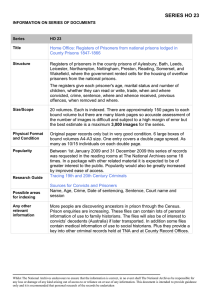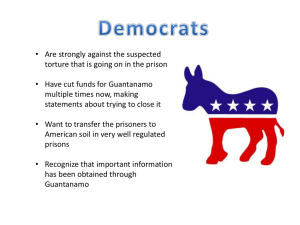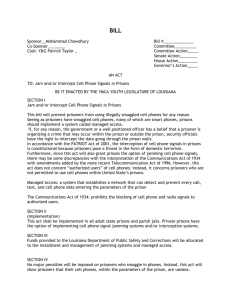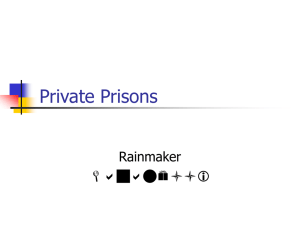QUESTIONS ON RHODES 1-224 1. 2.
advertisement
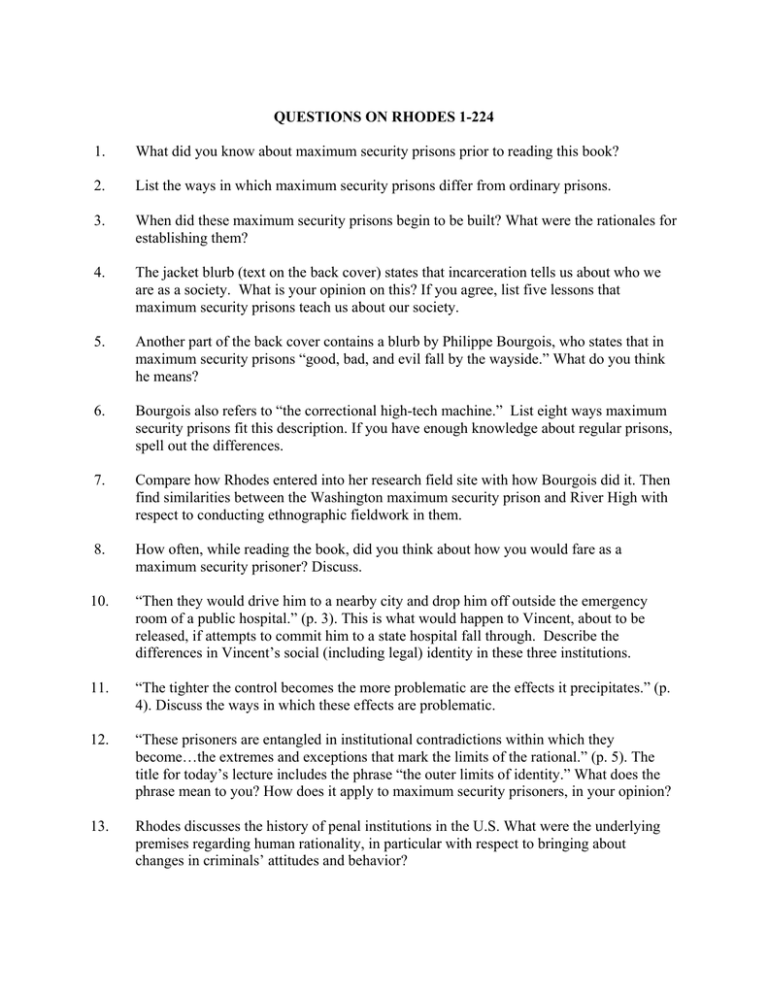
QUESTIONS ON RHODES 1-224 1. What did you know about maximum security prisons prior to reading this book? 2. List the ways in which maximum security prisons differ from ordinary prisons. 3. When did these maximum security prisons begin to be built? What were the rationales for establishing them? 4. The jacket blurb (text on the back cover) states that incarceration tells us about who we are as a society. What is your opinion on this? If you agree, list five lessons that maximum security prisons teach us about our society. 5. Another part of the back cover contains a blurb by Philippe Bourgois, who states that in maximum security prisons “good, bad, and evil fall by the wayside.” What do you think he means? 6. Bourgois also refers to “the correctional high-tech machine.” List eight ways maximum security prisons fit this description. If you have enough knowledge about regular prisons, spell out the differences. 7. Compare how Rhodes entered into her research field site with how Bourgois did it. Then find similarities between the Washington maximum security prison and River High with respect to conducting ethnographic fieldwork in them. 8. How often, while reading the book, did you think about how you would fare as a maximum security prisoner? Discuss. 10. “Then they would drive him to a nearby city and drop him off outside the emergency room of a public hospital.” (p. 3). This is what would happen to Vincent, about to be released, if attempts to commit him to a state hospital fall through. Describe the differences in Vincent’s social (including legal) identity in these three institutions. 11. “The tighter the control becomes the more problematic are the effects it precipitates.” (p. 4). Discuss the ways in which these effects are problematic. 12. “These prisoners are entangled in institutional contradictions within which they become…the extremes and exceptions that mark the limits of the rational.” (p. 5). The title for today’s lecture includes the phrase “the outer limits of identity.” What does the phrase mean to you? How does it apply to maximum security prisoners, in your opinion? 13. Rhodes discusses the history of penal institutions in the U.S. What were the underlying premises regarding human rationality, in particular with respect to bringing about changes in criminals’ attitudes and behavior? 2 14. Discuss the assumptions about humans, in particular misbehaving adult humans, underlying the maximum security prison technologies of punishment and containment. 15. In his Introduction Bourgois discusses structural violence as compared to individual agency (e.g., actor-centered). He also says he “cannot resolve the structure versus agency debate” (p. 18). How does this debate apply to an analysis of maximum security prisons? 16. What are some of the contradictions experienced by correctional workers in the maximum security prison, especially the guards? 17. Permanent, preventive detention. Discuss, bringing in, if you can, notions of human rights and citizen rights as expressed in the U.S. Constitution and penal law. Connect this practice and the ideology behind it to the notion of “preemptive strike” as a military strategy. 18. The U.S. has over 60 maximum security prisons. Make the argument that this kind of treatment is enlightened and civilized, especially when compared to earlier incarceration practices. Critique this position. 19. On p. 45 Rhodes speaks of “an element of attraction, even seductiveness, to this mining and manipulation of the body. It offers…an opportunity to play with meaning.” What is she referring to? 20. “One way a social boundary can be sustained is through the projection of disgust onto those on the ‘other’ side of it.” (p. 46). Discuss, then compare to River High and El Barrio. Gold stars if you can bring in Kondo. 21. “Many prisoners believe that they can leave these units only by ‘turning the other cheek,’ that is, through self-control bordering on self-abnegation.” (p. 55). Rhodes speaks of prisoners’ “logic of masculine self-respect” (p. 55). Compare to River High and El Barrio with respect to notions about power, weakness, and masculinity. 22. Describe some of the ways maximum security prisons “unsettle” and “complicate” “shared notions of individual autonomy, rational action, and free choice” (p. 59). 23. To what degree do officers make the prisoner obey them as individuals, “enacting his or her own will,” as opposed to the officer merely being “the efficient instrument of a larger, institutional power” (p. 63)? 24. Rhodes describes how “going to a control unit can be seen as a way to bolster a man’s reputation and protect him from assault later” (p. 78). She then quotes a prisoner who says “…you look at me, I’m young…I look like a fish [a new prisoner]…I’m probably gonna end up getting in a lot more fights.” Compare to El Barrio and River High. 25. Discuss the debate about stun belts and taser guns. 3 26. escribe the deinstitutionalization of public psychiatric hospitals in the 1970s and early D ‘80s, focusing on the effects on the U.S. penal system (p. 102). 27. Being in prison also “involves constant exposure to threatening or difficult interpersonal situations” (p. 113). List all the ways confinement exacerbates any tendency toward unstable mental state. 28. Discuss prisoners’ notions about masculinity, weakness and self-image as they relate to powerful medications like Mellaril and Thorazine (which prisoners refer to as “dummy dope”) (p. 115). 29. Discuss how mental health workers’ views about how prisoners should be treated differ from correctional officers’ (e.g., p. 119). 30. Prisoners and prison workers sometimes refer to “Catch-22” (e.g., p. 138). What does this phrase mean, and how does it apply to prisoners’ choices about their behavior? Does anyone know the origin of the phrase? 31. “Some officers feel that psychiatric medication interferes with this potential for responsibility; one objected that if prisoners are medicated ‘you can’t get into any of the causes of their behavior’.” (p. 156). Defend this position. Critique it. 32. Lack of conscience; antisocial (pp. 175-190). Discuss. Are these people “bad” or “mad”? Refer back to Question 17, about preventive detention. 33. List as many ways as you can in which “other than human” haunts maximum security prisons (p. 206). 34. “The prospect of less trouble threatens some staff and inmates because of the way control is understood as a matter of ‘hard’ versus ‘soft’.” (p. 208). “Less trouble” would seem to be a good thing. Describe the factors that make “less trouble” threatening. 35. “I showed them a video of Byrd in Texas…and one about Matthew Shepard.” (p. 214). Do you know who these men are? If not, read endnote #27. Then compare to similar expressions of hatred collected by Pascoe in River High and Bourgois in El Barrio. 36. “‘Making them human,’ being human, and humanizing oppose the ‘animal’ and the ‘inhuman’.” (p. 215). Discuss the methods used to get prisoners to think about these issues during class. 37. What’s the problem with the term “psychopath”? (p. 316) MIT OpenCourseWare http://ocw.mit.edu 21A.218J / WGS.170J Identity and Difference Spring 2010 For information about citing these materials or our Terms of Use, visit: http://ocw.mit.edu/terms.
